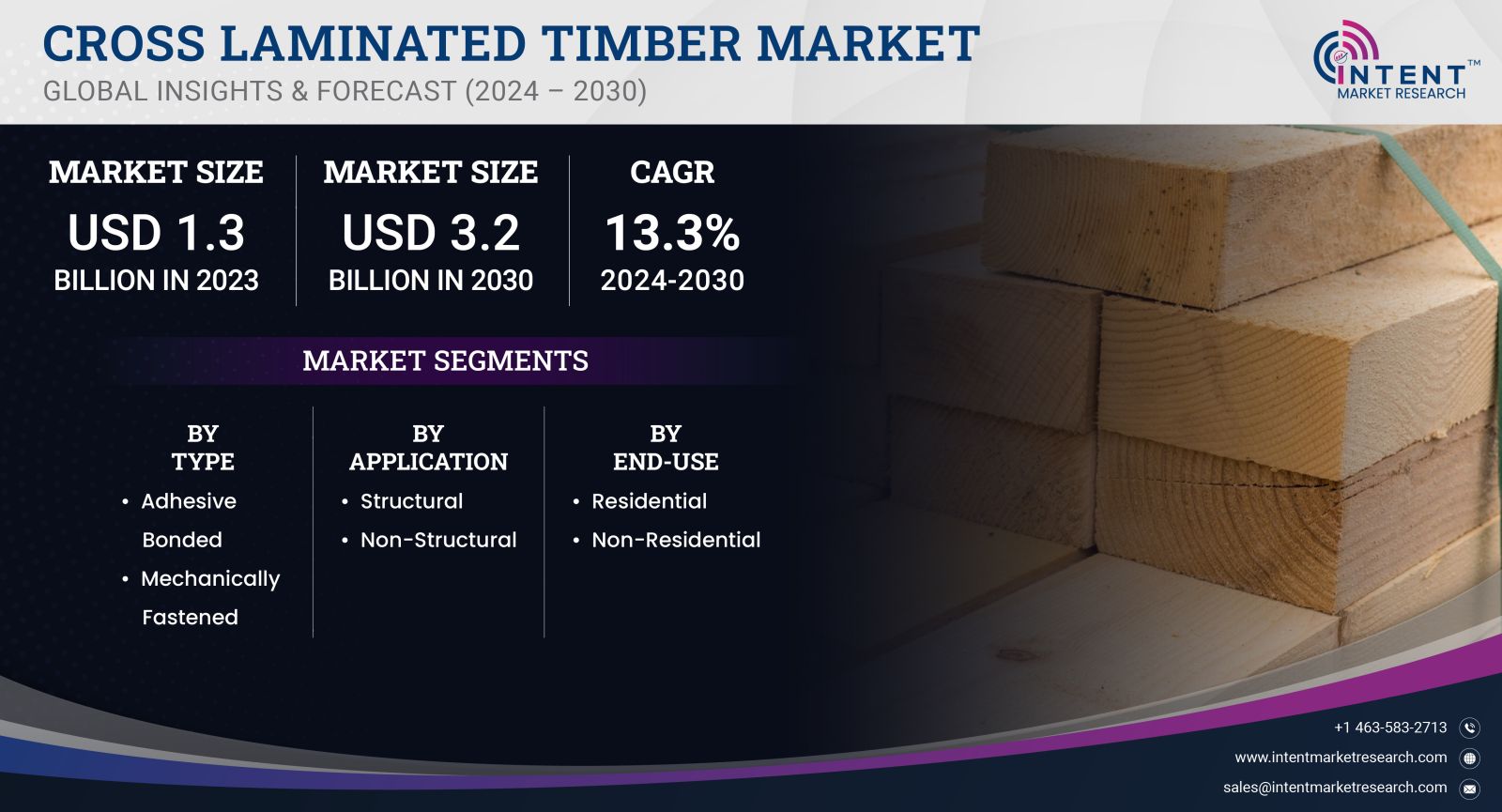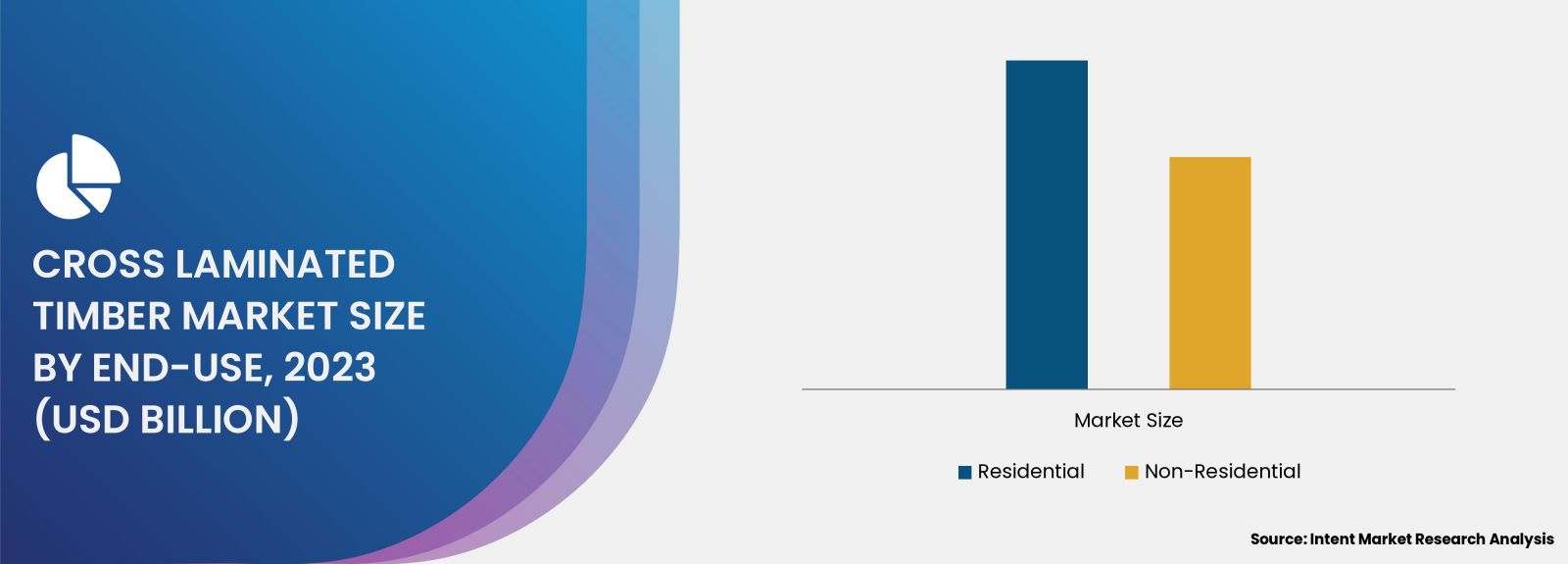As per Intent Market Research, the Cross Laminated Timber Market was valued at USD 1.3 billion in 2023 and will surpass USD 3.2 billion by 2030; growing at a CAGR of 13.3% during 2024 - 2030.

The Non-Residential Segment is Anticipated to Dominate the Cross Laminated Timber Market
The construction industry significantly impacts the environment, particularly in terms of resource consumption, such as water and electricity. Within this context, Cross Laminated Timber (CLT) has emerged as a highly sought-after material among construction firms, particularly for non-residential applications. This demand is attributed to CLT’s superior mechanical properties, structural stiffness, and aesthetic appeal.
Moreover, the non-residential building sector, including office spaces, public institutions, and hospitality facilities, presents substantial opportunities for CLT due to its advantages in architectural design and compliance with environmental regulations. These factors contribute to the growing preference for CLT in non-residential projects. Consequently, the non-residential construction market is expected to offer significant growth potential for CLT, likely resulting in its substantial market share in the coming years.

European Market is Expected to Account for the Largest Share of the Cross-Laminated Timber Market
Europe stands as the largest manufacturer of Cross-Laminated Timber (CLT), with the market significantly propelled by the swift growth of the residential construction sector. Increased awareness of the benefits of wooden products, such as their lightweight nature and ease of remodeling, is expected to boost demand for CLT, attracting more manufacturers to invest in this market.
CLT emerged as a preferred choice for building single-family homes while also proving ideal for multi-story, large-scale timber projects. This duality contributes to the stability of CLT prices, as manufacturing is typically tied to confirmed projects with predetermined delivery dates, quantities, and pricing. The minimal variability in CLT pricing is likely a contributing factor to its success; despite delivery times extending to ten weeks, CLT prices have remained relatively unchanged over the past several years.

The report focuses on estimating the current market potential in terms of the total addressable market for all the segments, sub-segments, and regions. In the process, all the high-growth and upcoming technologies were identified and analyzed to measure their impact on the current and future market. The report also identifies the key stakeholders, their business gaps, and their purchasing behavior. This information is essential for developing effective marketing strategies and creating products or services that meet the needs of the target market. The report also covers a detailed analysis of the competitive landscape which includes major players, their recent developments, growth strategies, product benchmarking, and manufacturing operations among others. Also, brief insights on start-up ecosystem and emerging companies is also included as part of this report.
Report Objectives:
The report will help you answer some of the most critical questions in the Cross Laminated Timber Market. A few of them are as follows:
- What are the key drivers, restraints, opportunities, and challenges influencing the market growth?
- What are the prevailing technology trends in the Cross Laminated Timber Market?
- What is the size of the Cross Laminated Timber Market based on segments, sub-segments, and regions?
- What is the size of different market segments across key regions: North America, Europe, Asia-Pacific, Latin America, Middle East & Africa?
- What are the market opportunities for stakeholders after analyzing key market trends?
- Who are the leading market players and what are their market share and core competencies?
- What is the degree of competition in the market and what are the key growth strategies adopted by leading players?
- What is the competitive landscape of the market, including market share analysis, revenue analysis, and a ranking of key players?
Report Scope:
|
Report Features |
Description |
|
Market Size (2023) |
USD 1.3 billion |
|
Forecasted Value (2030) |
USD 3.2 billion |
|
CAGR (2024 – 2030) |
13.3% |
|
Base Year for Estimation |
2023 |
|
Historic Year |
2022 |
|
Forecast Period |
2024 – 2030 |
|
Report Coverage |
Market Forecast, Market Dynamics, Competitive Landscape, Recent Developments |
|
Segments Covered |
Cross Laminated Timber Market By Type (Adhesive Bonded {Polyurethane, Melamine-Urea-Formaldehyde}, Mechanically Fastened {Self-Tapping Screws, Dowel-Type Fasteners}, By Application (Structural, Non-Structural), By End-Use (Residential, Non-Residential {Industrial, Public}) |
|
Regional Analysis |
North America (US, Canada, Mexico), Europe (Germany, France, UK, Italy, Spain, and Rest of Europe), Asia-Pacific (China, Japan, South Korea, Australia, India, and Rest of Asia-Pacific), Latin America (Brazil, Argentina, and Rest of Latin America), Middle East & Africa (Saudi Arabia, UAE, Rest of Middle East & Africa) |
|
Customization Scope |
Customization for segments, region/country-level will be provided. Moreover, additional customization can be done based on the requirements |
|
1. Introduction |
|
1.1. Market Definition |
|
1.2. Scope of the Study |
|
1.3. Research Assumptions |
|
1.4. Study Limitations |
|
2. Research Methodology |
|
2.1. Research Approach |
|
2.1.1. Top-Down Method |
|
2.1.2. Bottom-Up Method |
|
2.1.3. Factor Impact Analysis |
|
2.2. Insights & Data Collection Process |
|
2.2.1. Secondary Research |
|
2.2.2. Primary Research |
|
2.3. Data Mining Process |
|
2.3.1. Data Analysis |
|
2.3.2. Data Validation and Revalidation |
|
2.3.3. Data Triangulation |
|
3.Executive Summary |
|
3.1. Major Markets & Segments |
|
3.2. Highest Growing Regions and Respective Countries |
|
3.3. Impact of Growth Drivers & Inhibitors |
|
3.4. Regulatory Overview by Country |
|
4. Cross Laminated Timber Market, by Type (Market Size & Forecast: USD Million, 2022 – 2030) |
|
4.1. Adhesive Bonded |
|
4.1.1. Polyurethane |
|
4.1.2. Melamine-Urea-Formaldehyde |
|
4.2. Mechanically Fastened |
|
4.2.1. Self-Tapping Screws |
|
4.2.2. Dowel-Type Fasteners |
|
5. Cross Laminated Timber Market, by Application (Market Size & Forecast: USD Million, 2022 – 2030) |
|
5.1. Structural |
|
5.2. Non-Structural |
|
6. Cross Laminated Timber Market, by End-Use (Market Size & Forecast: USD Million, 2022 – 2030) |
|
6.1. Residential |
|
6.2. Non-Residential |
|
6.2.1. Industrial |
|
6.2.2. Public |
|
6.2.3. Others |
|
7. Regional Analysis (Market Size & Forecast: USD Million, 2022 – 2030) |
|
7.1. Regional Overview |
|
7.2. North America |
|
7.2.1. Regional Trends & Growth Drivers |
|
7.2.2. Barriers & Challenges |
|
7.2.3. Opportunities |
|
7.2.4. Factor Impact Analysis |
|
7.2.5. Technology Trends |
|
7.2.6. North America Cross Laminated Timber Market, by Type |
|
7.2.7. North America Cross Laminated Timber Market, by Application |
|
7.2.8. North America Cross Laminated Timber Market, by End-Use |
|
7.2.9. By Country |
|
7.2.9.1. US |
|
7.2.9.1.1. US Cross Laminated Timber Market, by Type |
|
7.2.9.1.2. US Cross Laminated Timber Market, by Application |
|
7.2.9.1.3. US Cross Laminated Timber Market, by End-Use |
|
7.2.9.2. Canada |
|
7.2.9.3. Mexico |
|
*Similar segmentation will be provided for each region and country |
|
7.3. Europe |
|
7.4. Asia-Pacific |
|
7.5. Latin America |
|
7.6. Middle East & Africa |
|
8. Competitive Landscape |
|
8.1. Overview of the Key Players |
|
8.2. Competitive Ecosystem |
|
8.2.1. Level of Fragmentation |
|
8.2.2. Market Consolidation |
|
8.2.3. Product Innovation |
|
8.3. Company Share Analysis |
|
8.4. Company Benchmarking Matrix |
|
8.4.1. Strategic Overview |
|
8.4.2. Product Innovations |
|
8.5. Start-up Ecosystem |
|
8.6. Strategic Competitive Insights/ Customer Imperatives |
|
8.7. ESG Matrix/ Sustainability Matrix |
|
8.8. Manufacturing Network |
|
8.8.1. Locations |
|
8.8.2. Supply Chain and Logistics |
|
8.8.3. Product Flexibility/Customization |
|
8.8.4. Digital Transformation and Connectivity |
|
8.8.5. Environmental and Regulatory Compliance |
|
8.9. Technology Readiness Level Matrix |
|
8.10. Technology Maturity Curve |
|
8.11. Buying Criteria |
|
9. Company Profiles |
|
9.1. Binderholz GmbH |
|
9.1.1. Company Overview |
|
9.1.2. Company Financials |
|
9.1.3. Product/Service Portfolio |
|
9.1.4. Recent Developments |
|
9.1.5. IMR Analysis |
|
*Similar information will be provided for other companies |
|
9.2. Eugen Decker & WebMan |
|
9.3. HASSLACHER Holding GmbH |
|
9.4. KLH Massivholz GmbH |
|
9.5. Mayr-Melnhof Holz Holding AG |
|
9.6. Mercer Mass Timber (MMT) |
|
9.7. PFEIFER GROUP |
|
9.8. Schilliger Holz AG |
|
9.9. Stora Enso |
|
9.10. XLam NZ Ltd |
|
10. Appendix |
A comprehensive market research approach was employed to gather and analyze data on the Cross Laminated Timber Market. In the process, the analysis was also done to analyze the parent market and relevant adjacencies to measure the impact of them on the Cross Laminated Timber Market. The research methodology encompassed both secondary and primary research techniques, ensuring the accuracy and credibility of the findings.
.jpg)
Secondary Research
Secondary research involved a thorough review of pertinent industry reports, journals, articles, and publications. Additionally, annual reports, press releases, and investor presentations of industry players were scrutinized to gain insights into their market positioning and strategies.
Primary Research
Primary research involved conducting in-depth interviews with industry experts, stakeholders, and market participants across the Cross Laminated Timber ecosystem. The primary research objectives included:
- Validating findings and assumptions derived from secondary research
- Gathering qualitative and quantitative data on market trends, drivers, and challenges
- Understanding the demand-side dynamics, encompassing end-users, component manufacturers, facility providers, and service providers
- Assessing the supply-side landscape, including technological advancements and recent developments
Market Size Assessment
A combination of top-down and bottom-up approaches was utilized to analyze the overall size of the Cross Laminated Timber Market. These methods were also employed to assess the size of various subsegments within the market. The market size assessment methodology encompassed the following steps:
- Identification of key industry players and relevant revenues through extensive secondary research
- Determination of the industry's supply chain and market size, in terms of value, through primary and secondary research processes
- Calculation of percentage shares, splits, and breakdowns using secondary sources and verification through primary sources
.jpg)
Data Triangulation
To ensure the accuracy and reliability of the market size, data triangulation was implemented. This involved cross-referencing data from various sources, including demand and supply side factors, market trends, and expert opinions. Additionally, top-down and bottom-up approaches were employed to validate the market size assessment.
.jpg)
